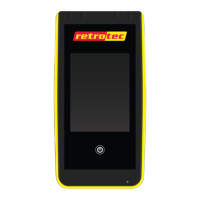Page 80 of 91
© Retrotec 2017
If the test pressure (20 in this case) is close to the desired reference pressure (25 Pa in this case), then the
correction is small and the value of n does not play as large a role. However, if the test pressure is much
higher or lower than the reference pressure, the error can be greater.
The @ Pressure feature is very useful for ensuring that results taken when the pressure was not adjusted
perfectly are still accurate.
To continue the above example: The flow at 20 Pa is 100 CFM. Actual n is 0.7, but this is unknown.
Instead, 0.6 will be used.
The gauge would calculate:
However, if it was known that n was 0.7, the flow at 25 should have been:
This value is less than 3% off from what it should be. If the test pressure was within 1 or 2 Pa of the
reference pressure of 25 Pa, the @ Pressure reading would be exact.
“n value” for @Pressure extrapolation
The “n value” is a number set between 0.5 and 1.0 that is used to extrapolate [Channel B] results to a
pressure that is not the pressure read on [Channel A]. It can be changed by tapping [Settings][…]
[Ducts=0.6, House=0.65]. Set it to 0.65 for houses, and 0.60 for ductwork. Set to 0.5 for tests using the
Retrotec House or duct simulator, air handler flow and any large hole that is not composed of long thin
cracks.
A wide open hole has an n of 0.5, meaning that when the pressure is quadrupled, the flow doubles. That is
due to completely turbulent flow going through that hole (flow = square root of pressure, a constant for
that particular hole).
An n value of 1.0 represents tiny little holes, so small that the air would not be turbulent but rather would
go through the holes as laminar flow. This means that when pressure is quadrupled, the flow will also be
quadrupled.
Houses and ducts have many holes that will have both turbulent and laminar flow going through them.
Duct holes tend to be slightly larger, whereas houses have more prevalent long tiny cracks, and therefore
tend to have lower n values.

